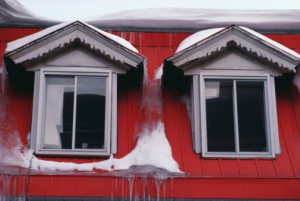Keep Your Roof Healthy by Preventing Ice Dams
December 21, 2012 11:52 amHomes and roofs here in Oklahoma have to be built to withstand the worst weather extremes. From blazing sun and tornadoes to ice storms and hail damage, we have come to expect the worst and often get it. With winter storms coming homeowners should be concerned about preventing ice from building up on their roofs.
Ice dams often form because heat rises inside your attic and collects at the upper portion of your roof while the lower area, near the eaves and gutters, remains cold. Falling snow hits the top of the roof and melts because it is warm. It then runs down to the colder area, accumulates and freezes into an ice dam. Water, snow and ice will build up behind this obstacle. The ice dam and the accumulated snow can damage gutters and push up shingles, exposing the underlayment and decking to potential damage. As the ice dam melts the water can leak into the joints of your home and run down the walls, causing cracks and potentially harmful mildew. Repairing any of this damage can be very expensive.

Never try to knock an ice dam off your roof as it could cause even more damage. There are some steps you can take to reduce their occurrence such as keeping gutters free of debris and raking heavy snow off your roof, but the best approach is to prevent ice dams in the first place. This goes back to two primary components dealing with the structure of your attic and the roof itself:
- Insulation: The purpose of insulation in an attic is to keep the entire roof area at a consistent temperature while preventing cold air from seeping into the living areas below the attic. To achieve this balance, you can install additional insulation on the attic floor or have more insulation blown into the attic, until you have achieved the optimal R-value for the area you are insulating. In our region the Department of Energy recommends an R-49 value, or about 16” of blanket insulation, for most attics. To calculate your home’s R-value use a ruler to measure the existing thickness of your attic insulation and multiply that by 3.14. You should also be sure to insulate or weather-strip areas in the attic where air may escape such as stairways, hatchways, or floor louvers.
- Ventilation: In addition to insulating it is necessary to have proper ventilation in an attic to prevent heat from building up. Minnesota’s Clean Energy Resource Teams recommend one square foot of vent areas for every 300 square feet of attic floor to keep roofing warranties, but most builders recommend a ratio of one square foot for every 150 feet of attic floor area for maximum ventilation. Additional vents may be needed for overhangs or soffits, along with a ridge vent at the peak of the roof.
A properly installed roof also helps to minimize ice dam damage. Ice dams should not be ignored because they mean there is something wrong with the way your home is utilizing energy. Van De Steeg & Associates has been preventing ice dams for Oklahoma homeowners since 1999. We understand how our sometimes crazy weather can really damage a home. If you’re not sure what to do about ice dams at your house, have us inspect your attic and roof to look for potential signs of danger before they become a real problem. Not only will you be able to sit inside and enjoy our Oklahoma winter, you’ll also save on utility costs when your house is properly insulated and ventilated.

